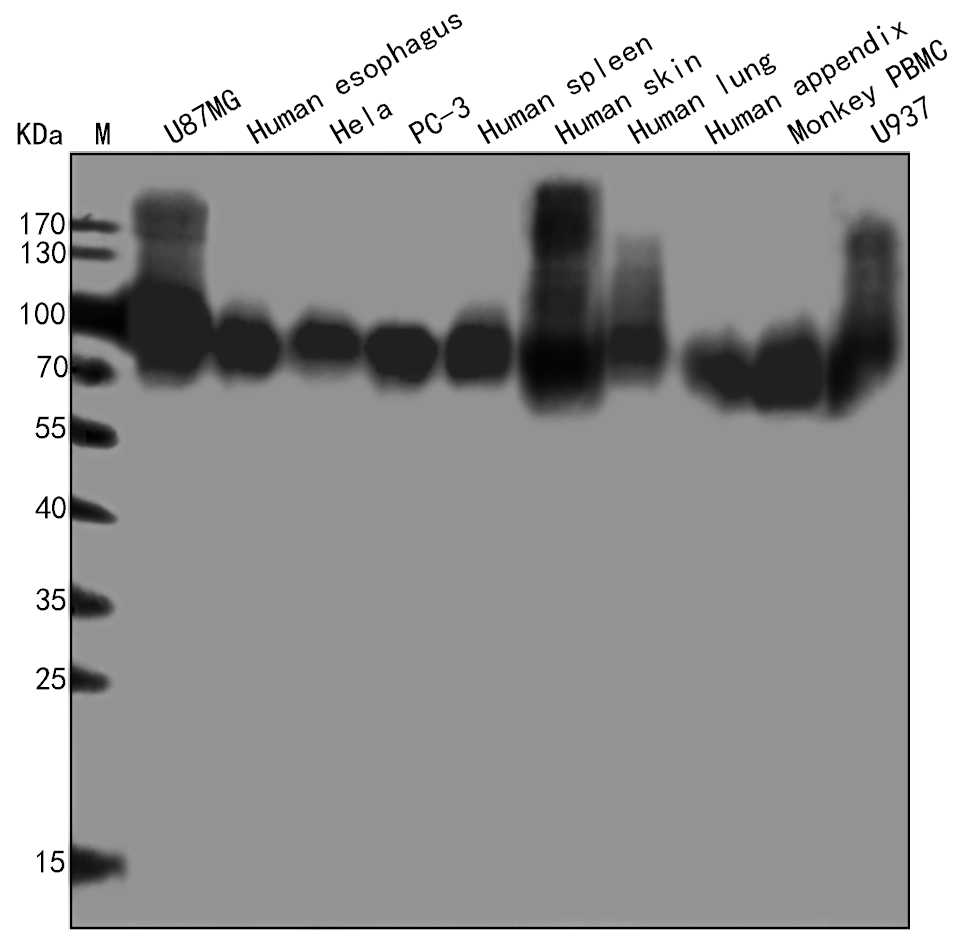
Anti-CD44 Antibody, Rabbit Polyclonal
產(chǎn)品編號(hào):PA00174HuA10
$ 詢(xún)價(jià)
規(guī)格 50uL 100uL 200uL 可選
產(chǎn)品名稱(chēng):Anti-CD44 Antibody, Rabbit Polyclonal
經(jīng)驗(yàn)證的應(yīng)用: WB/IHC/IF/ICC
交叉反應(yīng):/
特異性:Anti-CD44 Antibody, Rabbit Polyclonal
免疫原:Recombinant human CD44 protein, fragment Gln21~Leu338; UniprotKB: P16070
制備方法:Produced in rabbits immunized with human CD44, and purified by antigen affinity chromatography.
來(lái)源:Polyclonal Rabbit IgG
純化:Immunogen affinity purified
緩沖液:Supplied in PBS, 50% glycerol and less than 0.02% sodium azide, PH7.4
偶聯(lián)物:Unconjugated
狀態(tài):Liquid
運(yùn)輸方式:This antibody is shipped as liquid solution at ambient temperature. Upon receipt, store it immediately at the temperature recommended.
儲(chǔ)存條件:This antibody can be stored at 2℃-8℃ for one month without detectable loss of activity. Antibody products are stable for twelve months from date of receipt when stored at -20℃ to -80℃. Preservative-Free. Avoid repeated freeze-thaw cycles.
圖片:
Figure1.Western blot analysis of extracts of various cell lines using CD44 antibody (PA00174HuA10) at 1:1000 dilution. Lysates/proteins: 25ug per lane.Blocking buffer: 10% nonfat dry milk in TBST. Detection: ECL Basic Kit . Exposure time: 14s.
別稱(chēng):CDW44, CD44, CSPG8, ECMR-III, HCELL, IN, LHR, MC56, MDU2, MDU3, MIC4, MUTCH-I, Pgp1, Hematopoietic Cell E- And L-Selectin Ligand, Chondroitin Sulfate Proteoglycan 8
背景信息:CD44. CD44 is a ubiquitously expressed protein that is the major receptor for hyaluronan and exerts control over cell growth and migration (1-3). Human CD44 has a 20 amino acid (aa) signal sequence, an extracellular domain (ECD) with a 100 aa hyaluronan-binding disulfide-stabilized link region and a 325-530 aa stem region, a 21 aa transmembrane domain, and a 72 aa cytoplasmic domain. Within the stem, ten variably spliced exons (v1-10, exons 6-15) produce multiple protein isoforms (1-3). The standard or hematopoietic form, CD44H, does not include the variable segments (1-3). Cancer aggressiveness and T cell activation have been correlated with expression of specific isoforms (1, 3). With variable N- and O-glycosylation and splicing within the stalk, CD44 can range from 80 to 200 kDa (1). Within the N-terminal invariant portion of the ECD (aa 21-220), human CD44 shares 76%, 76%, 86%, 83% and 79% identity with corresponding mouse, rat, equine, canine and bovine CD44, respectively. The many reported functions of CD44 fall within three categories (1). First, CD44 binds hyaluronan and other ligands within the extracellular matrix and can function as a “platform” for growth factors and metalloproteinases. Second, CD44 can function as a co-receptor that modifies activity of receptors including MET and the ERBB family of tyrosine kinases. Third, the CD44 intracellular domain links the plasma membrane to the actin cytoskeleton via the ERM proteins, ezrin, radixin and moesin. CD44 can be synthesized in a soluble form (4) or may be cleaved at multiple sites by either membrane-type matrix metalloproteinases, or ADAM proteases to produce soluble ectodomains (5, 6). The cellular portion may then undergo gamma secretase-dependent intramembrane cleavage to form an A beta -like transmembrane portion and a cytoplasmic signaling portion that affects gene expression (7, 8). These cleavage events are thought to promote metastasis by enhancing tumor cell motility and growth (1, 5).
全稱(chēng):CD44 antigen (CD44)
說(shuō)明書(shū):
 |
說(shuō)明書(shū) |

